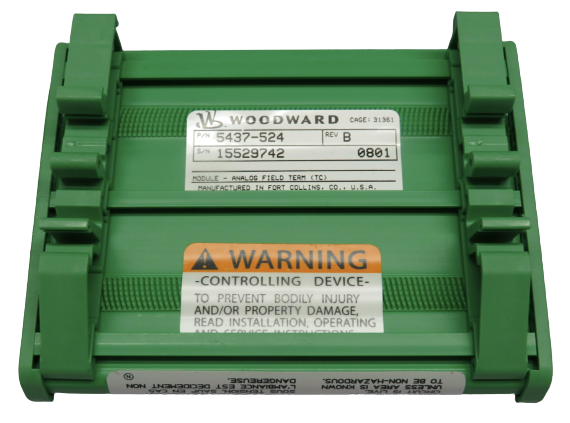SPECIFICATIONS
Part Number: 5437-524
Manufacturer: Woodward
Product type: Field Terminal Module
Availability: In stock
Country of Manufacture: United States (USA)
Functional Description
5437-524 is a Analog Field Terminal Module developed by Woodward. As an Analog FTM, it excels in handling continuous analog signals, making it an ideal choice for applications requiring precise monitoring and control. Its integration of standard screw clamp terminals simplifies the process of connecting field wiring, ensuring secure and dependable connections. With a 37-pin connector, this module offers flexibility in wiring configurations, allowing it to adapt to various industrial setups.
Features
- An Analog Field Terminal Module (AFTM) is a device used to interface analog signals from the field with the control system. It serves as a bridge between the field instruments and the central control system, allowing the measurement and control of analog variables such as temperature, pressure, flow, and level. The AFTM typically consists of analog input channels, analog output channels, and various signal conditioning circuits. The analog input channels receive signals from field devices such as sensors or transmitters and convert them into digital signals that can be processed by the control system. The analog output channels, on the other hand, convert digital control signals from the control system into analog signals that can be used to drive actuators or control devices in the field.
- The signal conditioning circuits in an AFTM are responsible for tasks such as amplification, filtering, isolation, and linearization of the analog signals. These circuits ensure that the signals from the field devices are accurately represented and compatible with the control system. AFTMs are typically designed to be mounted in the field close to the instruments they interface with. They are often housed in rugged enclosures to withstand harsh environmental conditions, such as high temperatures, humidity, and electromagnetic interference. AFTMs are commonly used in industries such as manufacturing, oil and gas, chemical processing, power generation, and water treatment.
Product Attributes
Analog Field Terminal Modules (AFTMs) come with various features that enable them to effectively interface with field devices and integrate analog signals into industrial control systems. Some common features include:
- Analog Input Channels: Typically include multiple analog input channels that can receive signals from field devices such as temperature sensors, pressure transmitters, flow meters, and level sensors. These channels are designed to handle different signal types (e.g., voltage, current, resistance) and signal ranges.
- Analog Output Channels: Have analog output channels that convert digital control signals from the control system into analog signals suitable for driving actuators or control devices in the field. These channels can generate signals such as voltage, current, or pulse-width modulation (PWM) outputs.
- Signal Conditioning: Feature built-in signal conditioning circuits that provide functions like amplification, filtering, isolation, and linearization. These circuits ensure that the analog signals from the field devices are accurately represented and compatible with the control system.
- High Resolution and Accuracy: Designed to provide high-resolution measurements and accurate signal processing. They can typically achieve high-resolution conversions with low noise levels, enabling precise measurement and control of analog variables.
- Communication Interfaces: Include communication interfaces to facilitate connectivity with the control system. Common communication protocols supported may include Ethernet, RS-485, Profibus, Modbus, or Fieldbus protocols. These interfaces enable seamless integration of the AFTM into the industrial network.
- Scalability and Expandability: Additional input or output channels can be added as needed, accommodating changes in the system requirements or the addition of new field devices.
- Configuration and Programming Options: This enables users to adapt the module's settings and parameters to suit their specific application requirements.
World of Controls has the most comprehensive selection of GE and Woodward components. Our professionals are available to help you with your requirements at any time. If you require any additional information, please contact WOC immediately.
Frequently Asked Questions
What is 5437-524?
It is a Field Terminal Module developed by Woodward.
What is the role of 24/8 Analog FTMs in the MicroNet system?
The 24/8 Analog FTMs serve as essential components for connecting and managing analog signals in the MicroNet system. They facilitate precise monitoring and control of analog inputs.
How are FTMs connected to the Modules?
Each FTM is connected to Module using a MicroNet High Density Analog/Discrete cable. This cable ensures a secure and reliable connection between the FTM and the module.
Why are fuses used in conjunction with these connections?
Each of the +24 Vdc connections is protected by a 0.1 A fuse. This protective measure helps safeguard the system against overcurrent or short-circuit conditions, ensuring the reliability and safety of the analog inputs.
